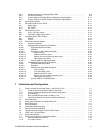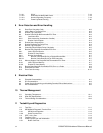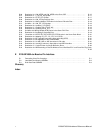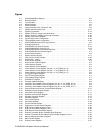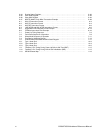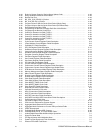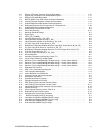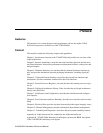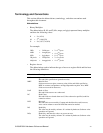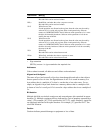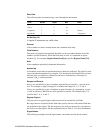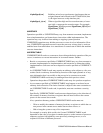21264/EV68A Hardware Reference Manual
xv
7–6 Effect on IPRs After Transition Through Sleep Mode . . . ........................... 7–10
7–7 Signals and Constraints for the Sleep Mode Sequence . ........................... 7–11
7–8 EffectonIPRsAfterWarmReset............................................. 7–11
7–9 WRITE_MANYChainCSRValuesforBcacheInitialization......................... 7–12
7–10 InternalProcessorRegistersatPower-UpResetState ............................ 7–14
7–11 21264/EV68A Reset State Machine State Descriptions . ........................... 7–17
7–12 Differential Reference Clock Frequencies in Full-Speed Lock . ...................... 7–20
8–1 21264/EV68A Error Detection Mechanisms ..................................... 8–1
8–2 64-BitDataandCheckBitECCCode.......................................... 8–2
8–3 ErrorCaseSummary....................................................... 8–10
9–1 MaximumElectricalRatings................................................. 9–1
9–2 Signal Types ............................................................. 9–2
9–3 VDD(I_DC_POWER)...................................................... 9–3
9–4 Input DC Reference Pin (I_DC_REF) .......................................... 9–3
9–5 Input Differential Amplifier Receiver (I_DA)...................................... 9–3
9–6 Input Differential Amplifier Clock Receiver (I_DA_CLK) . ........................... 9–3
9–7 PinType:Open-DrainOutputDriver(O_OD).................................... 9–4
9–8 Bidirectional,DifferentialAmplifierReceiver,Open-DrainOutputDriver(B_DA_OD) ..... 9–4
9–9 PinType:Open-DrainDriverforTestPins(O_OD_TP)............................ 9–4
9–10 Bidirectional,DifferentialAmplifierReceiver,Push-PullOutputDriver(B_DA_PP) ....... 9–4
9–11 Push-PullOutputDriver(O_PP).............................................. 9–5
9–12 Push-PullOutputClockDriver(O_PP_CLK)..................................... 9–5
9–13 ACSpecifications ......................................................... 9–7
10–1 OperatingTemperatureatHeatSinkCenter(Tc)................................. 10–1
10–2 qca at Various Airflows for 21264/EV68A . ...................................... 10–2
10–3 Maximum Ta for 21264/EV68A @ 750 MHz and @ 1.7 V with Various Airflows ......... 10–2
10–4 Maximum Ta for 21264/EV68A @ 833 MHz and @ 1.7 V with Various Airflows ......... 10–2
10–5 Maximum Ta for 21264/EV68A @ 875 MHz and @ 1.7 V with Various Airflows ......... 10–2
10–6 Maximum Ta for 21264/EV68A @ 940 MHz and @ 1.7 V with Various Airflows ......... 10–2
11–1 DedicatedTestPortPins.................................................... 11–1
11–2 IEEE 1149.1 Instructions and Opcodes . . ...................................... 11–3
11–3 TAPControllerStateMachine................................................ 11–4
11–4 IcacheBitFieldsinanSROMLine............................................ 11–7
A–1 InstructionFormatandOpcodeNotation ....................................... A–1
A–2 ArchitectureInstructions.................................................... A–2
A–3 Opcodes Reserved for Compaq . . ............................................ A–8
A–4 Opcodes Reserved for PALcode. . ............................................ A–9
A–5 IEEE Floating-Point Instruction Function Codes . ................................. A–9
A–6 VAXFloating-PointInstructionFunctionCodes .................................. A–11
A–7 Independent Floating-Point Instruction Function Codes . ........................... A–12
A–8 OpcodeSummary......................................................... A–12
A–9 KeytoOpcodeSummaryUsedinTableA–8.................................... A–13
A–10 RequiredPALcodeFunctionCodes........................................... A–13
A–11 Exceptional Input and Output Conditions ...................................... A–15
E–1 BcacheForwardingClockPinGroupings...................................... E–1
E–2 Late-WriteNon-BurstingSSRAMsDataPinUsage............................... E–2
E–3 Late-WriteNon-BurstingSSRAMsTagPinUsage................................ E–2
E–4 Dual-DataRateSSRAMDataPinUsage....................................... E–3
E–5 Dual-DataRateSSRAMTagPinUsage........................................ E–4



